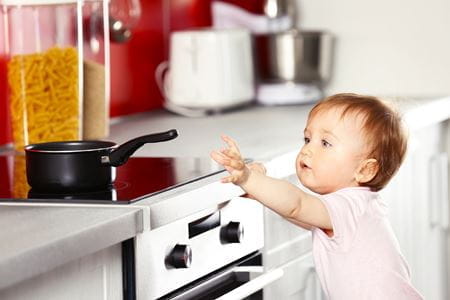Scalds can happen to anyone, but young children, older adults, and individuals with disabilities or health care needs are the most vulnerable to injury. They are more likely to require hospitalization, suffer complications, and endure difficult recovery periods. Most scalds happen at home from hot foods and beverages, or hot water in sinks, bathtubs, and showers. Scalds can also occur when people are exposed to steam or hot grease. Children have thinner skin and scald quicker and more deeply than adults exposed to the same temperature for the same amount of time. In addition, the proportion of a child’s body exposed to a scalding substance is also greater than that of an adult.
Kitchen and Dining Area Safety Tips:
- Establish a “kid safe area” out of the traffic path of the stove and the sink where children can play, but still be supervised. Supervision is the key in prevention of accidental scald burns!
- Use back burners for cooking, and always turn all pot handles toward the center of the stove to limit access to children. Purchase a stove guard that attaches to the front of your stove to help prevent children from reaching burners.
- Be aware of steam! When removing the lids from hot foods, lift the lid away from your arms and face. Wear short sleeves or tight fighting clothes when cooking.
- Be careful when cooking with deep fat fryers or cookers. The grease can easily reach temperatures of 400 degrees and cause serious burns in fewer than 1 second. Keep fryer cords out of the reach of children.
- At mealtime, place hot items in the center of the table at least 10 inches from the edge. Avoid using tablecloths if you have small children who could pull on them and spill hot food.
- Never drink or carry hot liquids when holding a child or place hot liquids on low tables where children can reach them. Use mugs with lids.
- Install microwave ovens at a safe height, within easy reach to avoid spills. The face of the person using the microwave should always be higher than the front of the door.
- Avoid using the microwave to heat bottles of formula or milk, especially bottles with plastic liners. Always test the formula or milk on your inner wrist or the back of your hand to make sure that it is a safe temperature.
- Foods cooked in the microwave are hot and may cook unevenly. Always stir and test foods., handle them properly, and cool them before serving
Hot Water Safety Tips:
- • Always supervise children in the bathtub; Do not ever leave them alone there!
- Never leave the room while you are filling the bathtub. Always run the cool water first then the hot, and test the temperature. The safest temperature for bathing is about 100° F. Purchase a bath water thermometer to help determine if water is safe for use.
- Clearly mark the hot water position on all faucets, and do not allow a young child to adjust the water temperature.
- When bathing young children, seat them facing away from the faucet so they cannot reach it. Always turn the faucet to the cold position when not in use.
- Install anti-scald devices. These devices are heat sensitive, and stop or interrupt the water flow until it reaches a pre-set temperature, and prevent hot water from coming out of the tap.
- Adjust your water heater thermostat to a safe level to no higher than 120°F. (**120°F is an upper limit for safety) Consult the user’s manual or a professional to assist if you are unable to do so. more information about scald prevention and safety products.
Call The Safety Store Helpline at 317-274-6565 for more information on scald & burn prevention
